#HogwartsLessons
Photo
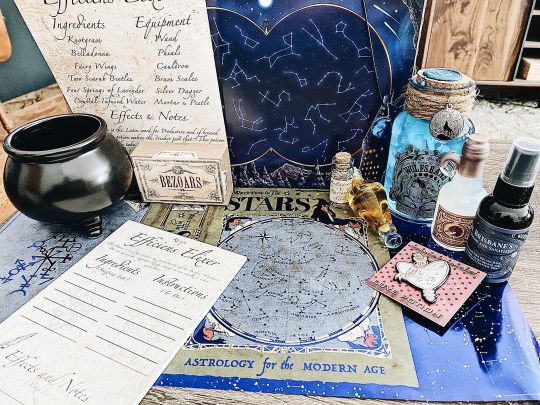
The Wizarding Trunk lessons box 5 : Potions and Astronomy So excited to keep expanding my potion collection #harrypottersubscriptionbox #thewizardingtrunk #hogwartslessons #potions #astronomy #harrypotter #subscriptionbox #unboxing #wizardryworkshop #purebloodapothecary #alchemyfortheskin #jpmisslecrow #fan #fanart #fanmerch https://www.instagram.com/p/CLPRyGmAGHYV9P9H5QAr8yWUCIUhi26O7HqPAs0/?igshid=5sr36y434mug
#harrypottersubscriptionbox#thewizardingtrunk#hogwartslessons#potions#astronomy#harrypotter#subscriptionbox#unboxing#wizardryworkshop#purebloodapothecary#alchemyfortheskin#jpmisslecrow#fan#fanart#fanmerch
0 notes
Text
Charms| Thursday. July 12th, 2018| Lesson Six: Memory Charm, Tickling Charm, General counter-spell
A Memory Charm (Obliviate), also known as a Forgetfulness Charm, was a spell that could be used to erase memories from an individual's mind. It was different from the charm that creates false memories
Incantation: Obliviate (oh-BLI-vee-ate)
Type: Charm
Hand movement:

Light: Green
Effect: Erases memory
Creator: Mnemone Radford (1562-1649)
Mnemone Radford was the witch who first developed Memory Modifying Charms. She became the first Ministry of Magic Obliviator, due to her skill with the charm.
These spells are used routinely by the Ministry of Magic as they work to keep the wizarding world a secret from the Muggles.
Minister for Magic Ottaline Gambol was responsible for the creation of the Hogwarts Express to transport young witches and wizards to Hogwarts. However, the secrecy surrounding the project entailed a mass operation involving one hundred and sixty-seven Memory Charms and the largest ever mass Concealment Charm performed in Britain.
Some Muggles slipped through the cracks in these situations, according to Blenheim Stalk in Muggles Who Notice. When particularly intense memories needed to be erased, it often left the victim disoriented for a short period of time, as happened with the Roberts family after the Quidditch World Cup in 1994.
If performed improperly, a Memory Charm could erase significant portions of an individual's memory and cause brain damage, with difficulty in recovery. For instance, Gilderoy Lockhart attempted to wipe the memories of Harry Potter and Ron Weasley during the events surrounding the re-opening of the Chamber of Secrets.
However, Ron's damaged wand backfired, thus causing Lockhart to suffer extreme obliviation. He thereafter became a permanent resident in the Janus Thickey Ward of St Mungo's. Although Lockhart did retain some of his memories (mainly his vain liking for signing autographs despite not knowing why, and knowing how to write in cursive), he never fully recovered.
Barty Crouch Snr placed a Memory Charm on Bertha Jorkins to try to make her forget her discovery that he was keeping his son in captivity. However, the charm he put on her was was too strong, and thus it damaged her memory permanently, making her chronically forgetful about other things as well.
Breaking the charm:
Memory Charms could be broken through torture. In 1994, Lord Voldemort and Peter Pettigrew broke a Memory Charm placed by Barty Crouch Snr on Bertha Jorkins, and extracted information from her regarding the whereabouts of Crouch's son. However, the breaking of the charm had caused a great toll on Bertha, and her body and mind was damaged beyond repair.
In 1997, Voldemort had Antonin Dolohov and Thorfinn Rowle tortured with the Cruciatus Curse after they failed to capture Harry Potter. Hermione Granger had cast Memory Charms on them so as to cover the trio's tracks. It appears that the charms were not broken by torture, since the Death Eaters remained unaware that Ron Weasley was with Harry and Hermione, rather than sick at home with spattergroit, as had been claimed. This may mean that a certain level of torture was necessary to break the charm, or that the torturer needed to be specific on wanting to break it, rather than just inflicting the pain.
Since Lockhart's backfired Memory Charm was never been broken through, it is possible that torture was the only method of complete recovery (with possibly irreparable mental and physical damage being clear side-effects), as it is doubtful that St Mungo's Hospital for Magical Maladies and Injuries would commit crimes against humanity just to recover Lockhart's memory. It is also possible, however, that since it was cast improperly, Lockhart's memory was actually erased permanently with no chance of recovery whatsoever. Although spending time in the hospital did help him regain the basics of his memory — mainly to write in cursive and his enjoyment of signing autographs, the latter of which he does not remember why — he never fully recovered.
Etymology
The incantation "obliviate" may be derived from the Latin oblivisci, meaning "to forget", or the English word oblivion, defined as "the fact or condition of forgetting or having forgotten".
It may be derived from the Latin term oblivio, which also means "to forget"
The Tickling Charm (Rictusempra), also known as the Rictusempra Charm, is a spell that causes a victim to buckle with laughter. It also has at least two other side effects on the victim.
Incantation: Rictusempra (ric-tuh-SEM-pra)
Type: Charm
Hand movement:

Light: Silver
Effect: Tickles and weakens
It is usually used as a diversionary tactic in duels. Harry Potter used it on Draco Malfoy in the Duelling Club during their second year. It is not known if this affects a person who is not ticklish, however in the Chamber of Secrets film, Malfoy was knocked backwards instead, and perhaps this could be the effect on a person not ticklish.
General Counter-Spell
The General Counter-Spell (Finite or Finite Incantatem) is a counter-spell for general use. It may be used in duels or on an entire home, as a precaution before a wizard answers the door. It is taught at Hogwarts School of Witchcraft and Wizardry.
Incantation: Finite (fi-NEE-tay)
Finite Incantatem (fi-NEE-tay in-can-TAH-tem)
Type: Counter-spell
Hand movement:

Light: Red
Effect: Terminates all spell effects
The General Counter-Spell terminates all spell effects ranging from simple spells like the Jelly-Legs Jinx to more complicated spells such as Atmospheric Charms.
2 notes
·
View notes
Text
Herbology| Wednesday. July 11th, 2018| Lesson Nine: Fluxweed, Leaping Toadstool and Mandrake
Fluxweed
Fluxweed is a member of the mustard family known for its healing properties. The word “flux” means constant change or flow which only makes sense for this plant being an ingredient in the Polyjuice Potion. If to be used in making Polyjuice Potion, it should strictly be picked on a full moon.

Leaping Toadstool
A Leaping Toadstool, originally native to Great Britain, is a magical mushroom which has the ability to jump. It can grow from 3 to 4 inches in height and are often noticed for the robust and rounded stem, which is necessary for them to keep their balance while leaping. Leaping Toadstools cost three Galleons at the Apothecary in Diagon Alley, and can be found in the Forbidden Forest.
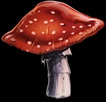
Mandrake
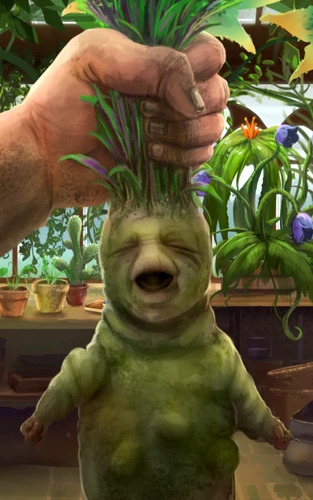
A Mandrake, also known as Mandragora, is a plant which has a root that looks like a human (like a baby when the plant is young, but maturing as the plant grows). When matured, its cry can be fatal to any person who hears it; a young Mandrake's screams will usually only knock a person out for several hours.
Mandrake plant has been used since ancient times as a medicinal plant and has a tradition associated with magical activities. It is a member of the nightshade family. It contains hyoscyamine, scopolamine, and mandragorin. Medically, it has been used as a pain killer and a sedative. It was used in ancient times for surgery. An overdose, though, can be fatal.
There are variations on the plant, Mandragora Offininarum being the most usual form, with the smaller Mandragora Autumnalis having the same properties. Some folk traditions call the latter (M. Autumnalis) variety as "Womandrake" in distinction to M. Officinarum as "Mandrake." A third variant, Mandragora Turcomanica, is a nearly extinct and very rare variety, found mostly in Turkey and a few areas of Iran. M. Turcomanica is distinguished from M. Autumnalis by having a larger fruit.
These plants are also known in the fields of medicine and potion making. Having knowledge about these plants could come in handy.
2 notes
·
View notes
Text
Mythology| Tuesday. July 10th, 2018| Lesson Sixteen: Intro to the Americas and Inuit
pAmerican Mythology The mythos of various American cultures is quite diverse, due to the large number of tribes and cultural groups that exist in the region. However, there are many overarching themes that can be drawn out and examined.
First of all, there is the concept of harmony in nature. In many cases, American peoples would take great pains not to upset the natural harmony of the world, and many of their rituals, myths, and societal practices reflect this belief. This is not an overly foreign concept to us, of course, as it is a common concept in other ancient societies which you have studied, with the Celts as a notable example.
Another commonality between ethnic groups in the Americas is their associations with animals, both magical and non-magical. Whether we are speaking of the jaguar of the Aztec, the bison of the Lakota, or the caribou of the Inuit, all groups had particular animals which they revered and with which they were closely associated. This connection, like their reverence for the harmony of nature, was expressed through myths about their societies and well as traditions and rituals based on cultural beliefs. As the year goes on, you will see a number of examples that demonstrate this point.
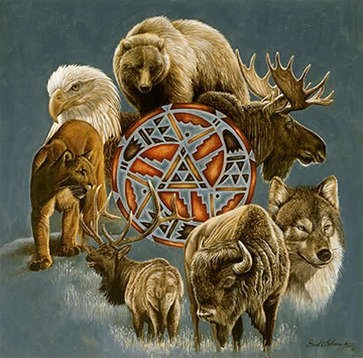
Finally, much like many other ancient societies, magic, myth, and history were highly intertwined. In some cases, so intertwined as to be indistinguishable from the others. That is to say, a historical account of a tribe’s existence may be completely based on their myths. However, recall that just because something is a myth does not automatically mean that it is untrue. Sometimes there is only the basic kernel of truth expressed at the center of the myth, but at other times, myths may recount actual historical events, people, or places. For example, the myth of Bellerophon and the chimera in Greco-Roman culture is full of references to mythological characters, however Bellerophon is the only wizard to have slain a chimera - which is a historical fact.
Keep your eyes open for similar characters and beliefs as we explore the mythologies of the Americas this year. To start us off, Professor Morgan will be discussing Inuit mythology for the remainder of our class today.
The Long and the Short of Inuit Mythology
Inuit mythology focuses strongly on animal associations, just as Professor Wessex has outlined for you above, such as those about the polar bear (nanook, in Inuktitut). What makes the Inuit myths quite fascinating and different from other cultures is that their focus is not on creation and the workings of the gods and the universe (although there are myths that outline these aspects of the world), but are more about survival in the treacherous environment in which they find themselves and the cultural values and experiences of the people themselves.
Now yes, I am speaking primarily of the cold, barren, arctic region of modern day Canada wherein the Inuit culture has flourished for thousands of years. Many of the myths speak of the hazards of the cold, and the dangers of the animals. Nanook, the Great Bear, is said to be almost human, and the greatest prey of all for a hunter. Of course, a polar bear is also the single most dangerous non-magical creature living around the arctic, and can just as easily kill a human as a hunter could kill it (or rather much more easily since polar bears are enormous, strong, and unafraid of humans.)
There are other creatures, however, that may seem mythical in nature to the Muggle population, but bear so many similar traits to known magical creatures that there may be that nugget of truth to them
The Qalupalik
Take for example, the magical cryptid known as Qalupalik. I see those of you who I assume are not studying Care of Magical Creatures looking blankly at me. Let me explain. A magical cryptid is a creature that is magical in nature, but has been seen so few times, that it is assumed to be merely rumor since no specimens have been recorded or captured to this day. Though mostly anecdotal in nature, there is still the possibility that these creatures do exist.
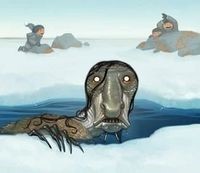
Yes. They are rather horrid looking, or at least this artist thought so. The myth can be summarized as follows:
The Qalupalik are creatures that live under the ice. They appear to be somewhat humanoid shaped and female. They wear a cloak with a large pouch called an amautiit (which the Inuit use to carry their children around), and make a humming sound audible to human ears from underneath the ice. As a gruesome twist, they eat children, sort of.
The myth states that the Qalupalik will grab children who come to close to the edge of the sea ice - especially those who misbehave and do not listen to their elders (which is what would land them at the edge of the sea ice unattended in the first place). The Qalupalik would snatch the child, shove them into the amautiit, and disappear under the ice.
If the first part of this myth is upsetting, the second part is down-right disturbing. The children were not immediately killed, but placed in a sort of stasis. They would remain in that stasis as the Qalupalik slowly drained off their life force -- I hope you remember the concept of a “life force”, that ever-changing thing which sustains the existence of all creatures, from your Defense Against the Dark Arts classes in Third Year. The child would age, most likely at a greatly accelerated rate, and the Qalupalik would absorb their youthfulness, keeping them more or less immortal.
As the only victims of the Qalupalik are never seen again, nor are there adults around when the creature strikes, it has been very difficult for magizoologists to verify the presence of this creature.
Sedna
Another very prominent myth in Inuit culture is that of the sea goddess. She goes by many names, including Sedna, Nuliayuk, and Taleelayuk, to name a few. The myth changes based on region and period of time, but we will look at one of the more elaborate versions, for reasons I will expound upon later.
The story begins with a young unmarried woman and a cold night, neither of which are uncommon in Inuit life. One evening, a stranger enters the family’s igloo and asks for shelter from the cold. The young man seems odd, and bears a necklace of two sharp canine teeth, but the family offers him hospitality and he spends the night in the family’s bed, where they sleep together for warmth. In the morning, the man has disappeared, and leading away from the house are animal tracks. The daughter of the family is found to be pregnant soon after.
Fearing what will come of such a union, the father forces his pregnant daughter to be dragged out on the ice to an island and abandoned. There, in secret and alone, she bears children, half of which appear normal in every way, and the other half who have canine features such as large ears and noses.

The second part of the myth, after her children are grown, tells of her father’s remorse and his attempt to return her to the village. Unfortunately, the rescue boat becomes trapped by a storm, and the captain, fearing the daughter is either bad luck or dead weight, throws her overboard. She attempts to climb back aboard, but she is cut from the boat many times -- literally -- which results in loss of limbs, to put it gently. These pieces of her are said to change shape and take the form of various sea animals. And while she does not ever make it back to the village, she becomes a powerful goddess of the sea, commanding these creatures of the sea that came from her own body.
In some versions, the woman is said to drown. While, in others, it is the father that forces his daughter to marry a dog due to her refusal to wed. Still others describe a great bird or fulmar that tricks her into marrying him and carries her off to an island away from her family. However, I have chosen this version to help illuminate some of the characteristics and facts this myth is thought to represent. Many a magihistorian has examined the versions of this myth and ultimately been unable to ignore the repeated animal transfigurations that feature throughout the tale. There are various competing schools of thought, some saying that this tale displays parallels to semi-modern “half-breed” prejudice, or distrust of those afflicted with lycanthropy, pointing to the stranger who takes the form as both canine and man as an example of a werewolf. However, others argue that this is potentially a heavily fabricated origin story of the first known Animagi in Inuit history and mythology. It is difficult to be sure, of course, but there is certainly more to this gruesome myth than meets the eye.
3 notes
·
View notes
Text
Mythology| Tuesday. July 10th, 2018| Lesson Fifteen: European Mythological Tendencies
Gods and Goddesses
All three of the cultures we discussed have pantheons, and in the case of the Celtic and Norse myths, more than one pantheon. True to all of the pantheons are the relationships of the gods to nature. The god of thunder is Zeus/Jupiter in Greco-Roman mythology and Odin in Norse mythology. Coincidentally both of these gods sit at the head of their respective pantheons. The Celtic god of the sea is Lugh, and the Greco-Roman counterpart is Poseidon/Neptune.
In this aspect of their mythologies, all three cultures are demonstrating a connection between the natural world and the gods. Mostly, the myths are there to help explain natural phenomena. A sudden, brutal storm is an angry god demonstrating his displeasure, for example.
Main Character and Creatures
It is when we get to the myths themselves that there are some differences between the cultures. In the first two cultures we studied, the Greco-Romans and Norse, the gods feature prominently in the stories. There may be a mortal thrown in now and again, but the focus of the stories is on the gods.
In Greco-Roman mythology, the stories are mostly the antics of the gods themselves and have little effect on how mortals live their lives. These gods are immortal, and their deeds may cause a war or two on occasion, but even the heroes in these stories are either gods themselves, or descendants of gods or other magical creatures
In Norse mythology the stories focus on the gods in an almost singular fashion, although mortal heroes do occasionally have run ins with the gods - and magical creatures as well. The difference here is that the Norse gods can die, and the most significant myth is that of the destruction of the world - an event that will have extreme consequences in the mortal world.
The odd man out of this group of cultures is Celtic mythology. While a god or two will have a small part to play in a myth - the siring of Cuchulainn, for example - it is the mortals who feature most prominently and in all of their frailty.
Morals
If you think about the stories you were told as a child, such as The Warlock’s Hairy Heart, or similar, you also remember the morals that are taught through them. Always tell the truth, don’t steal, work hard, don’t dabble in the Dark Arts. While a bit less obvious, the myths of the Greco-Romans, Celts, and Norse often, if not always, have some sort of moral issue addressed in them. Quite often they discuss the effects of infidelity, such as the Trojan War, the burden of knowledge, such as Odin’s knowledge that Ragnarok was inevitable, and the dangers of tampering with magic, such as the love potion Tristan and Iseult consumed.
These myths also show the values that each society held dear such as bravery, duty, and intelligence, although it was quite infrequent that all three were found in a single hero. Odysseus is perhaps the stand-alone example of all three of these values, and his trials lasted for decades.
Copyright?
The last aspect of these myths to compare is the similarities between the tales themselves. There are many examples where aspects of myths from two completely different cultures are found to be identical in their telling. The one that stand out the most from our studies this year is the white and black sail confusion. In Greco-Roman mythology, Theseus falls asleep on the ship returning to his father and forgets to change the sails. Believing his son to be dead, Aegeus throws himself off the castle towers into the sea. Similarly in Celtic mythology, Tristan believes the ship bringing Iseult to heal him is flying black sails instead of white, and he dies of heartbreak, believing she has abandoned him.
So what do these similarities mean? Quite simply, that these cultures were never completely isolated from each other and aspects of their myths were absorbed into each other’s stories. This borrowing of aspects of the stories also demonstrates that, while often at war with each other over land, these cultures still held the same values at their core.
2 notes
·
View notes
Text
Mythology| Thursday. July 6th, 2018| Lesson Thirteen: Celtic Pantheon, Otherworlds, Seers, and Enchantments
Pantheons and Great Families
All of the mythologies we have covered in this class have had a very distinct pantheon. Some of the names may have changed or been adapted to fit local history, but they have remained more or less the same. This pattern changes with the Celtic people.
One very important thing to remember when discussing Celtic myths is that the Celtic people migrated significantly during their time, and therefore there are three distinct areas - often with distinct stories and pantheons as well. These areas are Ireland, Wales, and the mainland - now parts of modern-day France. The two most prevalent pantheons are the descendants of Dagda, also known as Daghda (Ireland) and The Children of Don (or Donn - Welsh), which are depicted below.

Ultimate Encyclopedia of Mythology
Some of you may be pondering why these charts seem shallow as compared to some of the other civilizations we have covered in this class. The truth is, they are much more complicated. Throughout many stories the genealogy of the gods is discussed, and these stories quite frequently contradict each other. There is so much contradiction, in fact, that scholars simply cannot agree on one interpretation over another. As such, there is not a genealogical chart that I can show you that will work for all of the stories we will discuss. You will simply need to understand each story on its own, disconnected with the others we will encounter.
Another factor that differs from other mythologies I have covered in previous lessons is that Celtic myths focus much more on the heroes than the gods. Certainly, the gods may be involved now and again, but it is the men and women of the great families that make up the vast majority of the myths. The three most notable of these families are those of Ulster, Fionn mac Cumhaill (Finn Maccool), and the Children of Llyr (Lir)
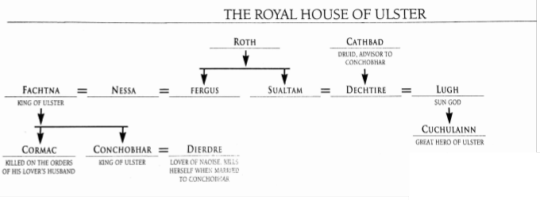
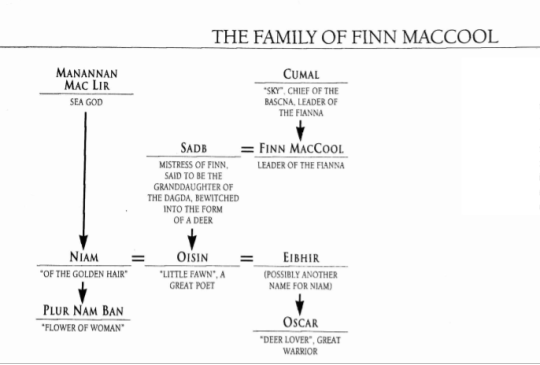
There are numerous other characters and genealogies that can be found when closely looking at Celtic mythology, however the ones above are more than sufficient for our brief foray into the topic.
The Celtic Otherworlds
Featuring prominently in Celtic mythology are references to the Otherworld, or Otherworlds. Similar to Norse mythology where Midgard, Niflheim, and the other worlds existed alongside each other, Celtic mythology also features several other parallel worlds to our own. Some scholars believe that these Otherworlds are simply different areas of a singular parallel world, but most believe that they are all separate, as journeys between Otherworlds do not occur in the myths.
The Otherworlds are the realms of the gods, spirits, fairies, elves, and giants. They are said to be the source of magical creatures, items, and practitioners, however their environments varied greatly. You could find yourself in an utopian paradise, or just as likely in hell. The landscape could be wooded or sterile, warm or cold - one could never tell before crossing over. Many characters in the myths travelled to one of these worlds, whether on purpose or by fateful accident, however, within these Otherworlds, time passed at a different rate. You could find yourself spending an hour in one, only to find that a decade or longer had passed in your own world.
Norse mythology featured a physical bridge connecting worlds, however Celtic mythology speaks more of a veil between worlds, a barrier that was thinner or thicker, depending on magical concentration and use, interference of the gods, and the time of year. It was universally acknowledged by the Celts that the veil between worlds was thinnest at Samhain.
One of the most famous Otherworlds was known as Annwn. This Welsh Otherworld was full of lush gardens, places to rest, and soothing bird songs. It was also home to a magical cauldron guarded by nine maidens. This cauldron was said to heal the sick and restore the dead to life. However, even the most beautiful and appealing Otherworld had its dangers. In this case, Arawn, Lord of Annwn, and his pack of hell hounds flew throughout the realm at night in pursuit of human souls. Best not to be out in magical forests after dark, wouldn’t you say?
Another well known Otherworld, this time of the Irish tradition, is Tír na nÓg, sometimes called Tír na hÓige. It is in this Otherworld where the majority of the Irish gods, called the Tuatha dé Danann, dwelled. The gods chose to live in this Otherworld after the arrival of the humans on their shores as it was the realm of everlasting youth, beauty, health, joy, and abundance. Humans were often lured to Tír na nÓg either by its eternalness or by the beauty of one of the gods.
The most famous story involving a human crossing to Tír na nÓg is that of Oisín and Niamh (or Niam). Oisín was a mortal man, son to Fionn mac Cumhaill, who fell in love with Niamh, who was from the Otherworld. Loving him as well, Niamh begged him to come to Tír na nÓg where they could live together, seemingly forever. Aiding Oisín in their journey was a horse that was capable of travelling over water, and together they crossed the veil.

Oisín and Niamh cross the veil
After about three years, Oisín grew terribly homesick and begged Niamh to let him return home to visit. She reluctantly gave him leave, but bade him to stay on the magical horse who would bring him back after his visit. Oisín agreed, and crossed the veil once more.
Upon Oisín’s arrival home, Oisín discovered that 300 years had passed on Earth during his absence. He was so shocked at this realization that he fell off of the magical horse. Alas, once his connection with the magic was broken, his connection to the Earth was renewed and he immediately aged as the missed years caught up to him. He passed away quite quickly.
Seers
Another common feature in Celtic mythology is the practice of divination, specifically by Druidic seers. As mentioned in Year Four of Ancient Studies, Druids kept no records of any kind. Therefore as we examine the myths involving seers, it is important to note that we are uncertain to this day if these myths are fact, fiction, or, in the most likely scenario, a combination of both. Three of the most famous of these seers are Amairgen (Amergin), Taliesin, and Cathbad.
Amairgen
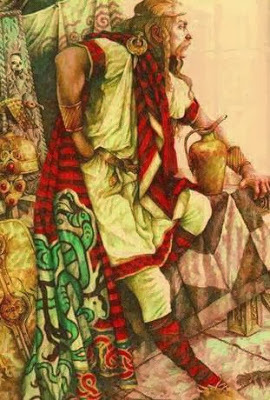
Amairgen, High King of Ireland
Amairgen was a very early Druid - one of the first of the Irish Druids. He was also the first High King of Ireland. He is most famous for a historic and lengthy battle, during which he negotiated - through sword and word and most definitely magic - permission to settle Ireland. During the largest sea battle of this conflict, Amairgen worked an incantation to call a great storm. His divinatory abilities made him aware that the casualties on both sides would be extensive, however he was running out of options. The incantation in the myth is more of a poem, and has been translated as follows by the Muggle Lady Gregory Augusta:
"I am the wind on the sea;
I am the wave of the sea;
I am the bull of seven battles;
I am the eagle on the rock
I am a flash from the sun;
I am the most beautiful of plants;
I am a strong wild boar;
I am a salmon in the water;
I am a lake in the plain;
I am the word of knowledge;
I am the head of the spear in battle;
I am the god that puts fire in the head;
Who spreads light in the gathering on the hills?
Who can tell the ages of the moon?
Who can tell the place where the sun rests?
Now I am certain that these words are not really part of the spell. As far as magihistorians can tell, there are no specific incantations in this passage, however if this myth were true, Amairgen would have been using a rune-inscribed staff and the words he said would have been superfluous to the spell - perhaps said even before he actually cast it. Regardless, this is one of the earliest myths to feature a druid.
Taliesin

Taliesin the Bard
Perhaps you have heard of our second druidic seer, Taliesin. On occasion you may see Taliesin as another name for Merlin, or as a companion of Merlin and King Arthur, however this is not accurate. They are indeed two different people living in two different times. Taliesin was known to Muggles as the greatest bard. In fact, one of his nicknames was Father of the Bards, for he could spin a great tale. Of course the ability to use charms to enhance those stories went a long way to bolstering his reputation!
It is, though, the lesser known abilities that make Taliesin stand out from the others. It was he who foretold and tried to warn the people about the arrival of the Saxons on their shores. He also warned of the resulting oppression his people would face, as well as his own death. The myths indicate that deep meditation gave him the visions of the future, and that he also journeyed to the Otherworld. It was also thought that he was an animagus who could turn into an eagle.
I’m sure most of you have noticed that Taliesin’s story sounds more historical than mythical. These stories are some of the most difficult for magihistorians to examine and sort into one category or another. I will leave you to decide for yourselves what you wish to believe. Regardless of your choice, you will become part of a debate that has lasted for centuries!
4 notes
·
View notes
Text
Mythology| Thursday. July 5th, 2018| Lesson Twelve: Of Treasures, Trials, and Endings
Freyja and Brisingamen
Two of the greatest magical weapons in Norse mythology belonged to the father/son pair of Odin and Thor. Odin was in possession of Gungnir - a great spear that never missed its mark. Odin himself fashioned the spear from the wood of Yggdrasil and carved magical runes into it.
Thor’s hammer, Mjölnir, was so heavy it was said that only he was able to lift it. While it was a weapon of great destruction - launching thunderbolts and lightening, and capable of smashing the skulls of giants - it was also a symbol of creation, and used in birth ceremonies as well.
Skidbladnir was the most fascinating magical structure in Norse mythology - at least that’s how I see it. Known as the god’s ship, Skidbladnir had been crafted by the dwarves, and could sail across the sea, as well as through the air and over land. As if that weren’t impressive enough, the ship could be folded up like a napkin and tucked into someone’s pocket! I definitely need to meet the dwarves who crafted this magic. I have a few rather large items I would love to be able to tuck away into a pocket!
Skidbladnir
Treasures and Talismans
Many Norse myths are centered around heroes searching for some sort of treasure. You could argue, however that both the greatest and worst treasures that these gods and heroes found were, in fact, magical talismans, weapons, structures, and rings of power.
The goddess Freyja was given one such talisman by four dwarves who had crafted it. This talisman was a necklace called the Brisingamen and it was said to have shone brighter than the stars. While it did not cause her any grief, it did cause her to produce treasure whenever she cried. If she was on land, and her tears fell on rock, they turned to gold. If she was at sea, however, she created amber with her tears.
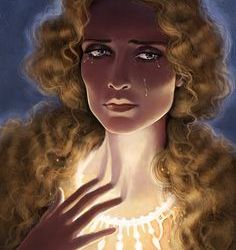
Freyja and Brisingamen
Two of the greatest magical weapons in Norse mythology belonged to the father/son pair of Odin and Thor. Odin was in possession of Gungnir - a great spear that never missed its mark. Odin himself fashioned the spear from the wood of Yggdrasil and carved magical runes into it.
Thor’s hammer, Mjölnir, was so heavy it was said that only he was able to lift it. While it was a weapon of great destruction - launching thunderbolts and lightening, and capable of smashing the skulls of giants - it was also a symbol of creation, and used in birth ceremonies as well.
Skidbladnir was the most fascinating magical structure in Norse mythology - at least that’s how I see it. Known as the god’s ship, Skidbladnir had been crafted by the dwarves, and could sail across the sea, as well as through the air and over land. As if that weren’t impressive enough, the ship could be folded up like a napkin and tucked into someone’s pocket! I definitely need to meet the dwarves who crafted this magic. I have a few rather large items I would love to be able to tuck away into a pocket!
Skidbladnir

The last piece of magic found quite frequently in Norse mythology are rings of power. Now, these rings were all symbols of fame, fortune, and power; however some were blessings, and some were curses.
On the blessing’s side, Odin’s ring Draupnir, dripped eight similar gold rings every ninth day, spreading its wealth. Thor’s Oath Ring was also seen as a promise of fair play and good faith. Other pure rings belonged to heroes such as Orthnit, Wolfdietrich, and Dietrich. These pure rings led the heroes to great treasures, such as, in the case of Dietrich, a cape of invisibility, a girdle of strength, a magical sword, and a hoard of highly-valued rings.
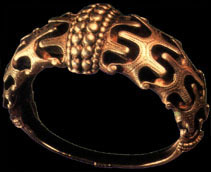
Draupnir
Many rings of power, however, were tainted by corruption and greed, and so they cursed and corrupted their bearer, even if their bearers began pure of intention. An example you are already somewhat familiar with is the ring Andvaranaut. This ring was cursed by Andvari. Hreidmar inherited the ring, who was killed by Fafnir (whom you may recall from our previous lesson), who was in turn killed by Sigurd, to whom also befel a tragic fate.
Before accepting a magic ring, dears, please be sure to have it thoroughly checked out. Don’t even touch it. In fact, just walk away. No ring of power is worth your life!
Magic use in Mythology
While we know that there were magic practitioners in the Norse civilization, it is very interesting to note who could use magic in their myths. While many mythologies across the world have their entire pantheon capable of working magic, this was not the case in Norse Mythology. If you recall from our previous lesson this year, the gods were broken up into two groups: the Aesir and the Vanir. It was the Vanir who possessed the magic, not the Aesir.
Certainly the Aesir could benefit from magic. As we just discussed, many of them both owned and used several magical talismans. Thor alone held two magic rings as well as Mjölnir. They simply did not make the items themselves, nor were they able to practice any magic on their own.
But what about Odin? Yes, Odin was Aesir, but also think back to our tales of Odin as a hero. He spent an incredible amount of time and energy - not to mention self-sacrifice - to achieve great knowledge. In his search for knowledge, Odin learnt every possible thing about magic that he could from the Vanir, Freyja.
Ragnarok
One of the aspects of Norse Mythology that I find most fascinating is their myths surrounding the end of the world. In and of itself, it is not very common for a culture’s mythology to detail the end of the world. Some certainly do, but the detail in which the Norse end of the world myth is outlined is rather impressive.
In our last lesson, we spoke about Odin and his relentless and self-sacrificial pursuit of knowledge and wisdom. The single driving force behind this quest was to find a way to stop Ragnarok - the Norse term used to describe the events which culminated in the end of the world - from occurring. Sadly, this pursuit was in vain, as Odin learned that the one event that was the catalyst of Ragnarok, the harbinger of doom, if you will, had already occurred. Because that event had already transpired, Ragnarok was inevitably unavoidable.
The doomsday event that signaled the beginning of the end, as it were, was the death of the god Baldur (aka Balder, Baldr), by means of Loki’s treachery. This death also signalled Loki’s descent to the dark side, if you will, and his eventual role as the leader of the end of the world.
You may be wondering why the death of this one god was so pivotal. Because he was the best of them. Baldur was the one that never did anything wrong. He was kind and generous and forgiving. He was known as the gentle god, and also as the god of love, peace, forgiveness, justice, light, and purity. He was a son of Odin, and Thor’s half-brother.

Baldur, god of goodness and light
When Baldur was young, he and his mother both had a vision of his death. So outraged were the gods by this prospect that they ordered all living things - plants, animals, and gods alike - to swear an oath never to harm Baldur. The myth becomes a bit murky at this point as there are several versions, but the general theme is that one plant did not swear this oath. The plant has been referred to as either mistletoe, which did not swear because it was too young to be able to swear a binding oath, or a willow tree that was under a spell from Loki causing it to refuse to take that oath. In the willow tree version of the story, once Loki’s spell wore off, the willow bent its branches and wept for eternity for the treachery it had been a part of, hence the common name “weeping willow” for that particular species of tree.
Regardless of which plant it was, Loki fashioned a spear or an arrow, depending on the version of the myth you are reading, and gave it to Baldur’s twin brother Hodr (aka Hod), who was blind. At that time in the lives of the gods, they often took great sport in throwing objects and weapons at Baldur who had become for all intents and purposes invulnerable to injury through the oaths that had been taken to protect him.
I’m sure you can guess what happened next. Hodr threw the spear (or arrow) at Baldur, and he was killed. Enraged, Odin mated with a giantess who gave birth to Vali, who in turn grew to adulthood in one day. Vali’s sole purpose was to kill Hodr to avenge Baldur’s death, which he did. Yes, Loki got away with it.
Maybe it was that Loki got away with it that was truly the unstoppable catalyst, for from that point onward he was no longer Thor’s friend and confidante, but more cruel, more meddlesome, and, ultimately, so evil as to intentionally try to end the world.
And so this is what the Norse have predicted the end of the world will be. Loki, his offspring, and the giants will come together against the gods of Asgard who have gathered their own hoards of dead warriors in Valhalla. A great battle will take place, during which Asgard will be destroyed, along with Bifrost.
2 notes
·
View notes
Text
History of Magic| Friday. June 22nd, 2018| Lesson Three: British Wizarding Villages I
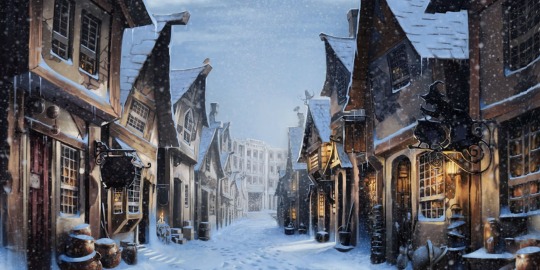
Hogsmeade
I’m sure many of you are very familiar with Hogsmeade, but unfortunately, you’ll only be allowed to visit the Hogsmeade Village after you reach your Third Year. So, for now, you can just learn the history of Hogsmeade to appreciate the beauty of the place in the near future.
Hogsmeade is perhaps the most popular wizarding village in Britain, and it is also the only all-magical community in Britain, unlike those which are communities within a larger Muggle city or region. Hogsmeade is located to the northwest of Hogwarts School of Witchcraft and Wizardry. If you look closely at the architecture of Hogsmeade, you will see most of it is from medieval times. One good example of a medieval building would be the Three Broomsticks, an ancient inn, allegedly built on the site of Hogsmeade’s founder’s house.
The town was founded sometime between 1010 and 1030 by Hengist of Woodcroft, a medieval wizard. Hengist of Woodcroft was actually escaping to Scotland from a Muggle witch-hunt in Northumberland. He is believed to have created his home where the The Three Broomsticks currently stands, but no sources have actually managed to confirm is this is a fact or a myth.
After the International Statute of Secrecy was signed in 1689, there was an influx of new residents escaping the Muggle witch-hunts who found solace in Hogsmeade, as did others did with many other wizardings village in Britain at that time. For the most part, they remained there with their families and their descendents currently make up a large part of the population of our dear Hogsmeade.
Hogsmeade also has a rich history, partly due to the connections it has with Hogwarts School of Witchcraft and Wizardry. Thus, the village has seen the growth of Hogwarts on a very personal level. As mentioned, Third Years and up have been allowed to visit Hogsmeade since 1500 CE. There have been times when this privilege was briefly suspended, namely during 1612 -- due to the Goblin Rebellion -- and again for the years 1997 through 1998, preceding and during the Battle of Hogwarts.
In the Goblin Rebellion of 1612, The Three Broomsticks Inn was used as the wizards’ headquarters during the catastrophic rebellion. It happened to also be the first goblin rebellion of many happening in wizarding history.
Throughout the school year of 1997 to 1998 and during the Battle of Hogwarts on May 2nd , 1998, The Hog’s Head Inn was used to house members fighting at Hogwarts, as well as those living in Hogsmeade. It contained a secret passageway that let into Hogwarts’ Room of Requirement. It had another two purposes as well: to serve as a route for Order of the Phoenix members and supporters to enter the school to join the battle, as well as a means to evacuate underage students from the school.

Godric’s Hollow
Godric’s Hollow is an unofficial wizarding community that is actually within another community, in the West Country of England. Despite not being a pure wizarding village, many wizards and witches still resided in Godric’s Hollow in large numbers, especially after the International Statute of Secrecy was taken into effect. However, magical beings still need to be wary of using their magic in the open so as to not startle any Muggle residents.
I’m sure that as students of Hogwarts, you would be able to recognise the name of the village and its origin is not too hard to guess. Godric’s Hollow got its name from Godric Gryffindor. Even though the village was known to be his birthplace, it was named after him because after he rose to fame and became the most well-known resident of the area. However, there were other influential figures that also lived there, such as the Dumbledores, the Peverells, Bowman Wright, the Potters, and also Bathilda Bagshot.
Godric’s Hollow is, in fact, not an all-wizarding village, despite its prominence, because the village was founded long before the Statute was put into place. This requires a fair bit of clever magic to conceal monuments such as the shell of the Potter household.
While tragic, the events at the Potter household were not the only events that have shaped the town’s history. Let’s take a brief look at some other landmarks that happened there.
First Duel between Albus Dumbledore and Gellert Grindelwald (1899)
In 1899, a three-way duel between Albus Dumbledore, Gellert Grindelwald, and Aberforth Dumbledore occurred in Godric’s Hollow. This duel also marked the end of the close ties between the Dumbledores and the Grindelwald. During the duel, Ariana Dumbledore -- 14 at that time -- attempted to help but instead was accidentally killed.
First Downfall of Lord Voldemort (1981)
On the 31st of October 1981, Lord Voldemort murdered Lily and James Potter in their home in Godric’s Hollow. He also attempted to kill Harry Potter, however, due to the ancient magics surrounding Lily Potter’s sacrifice for her son, Lord Voldemort ended up losing his power and physical form. The Potters’ bodies now reside in Godric’s Hollow’s graveyard.
Mould-on-the-Wold
Whilst Hogsmeade and Godric’s Hollow are more well-known villages, Mould-on-the-Wold is another important wizarding village in England. It is best recognised as the childhood home of Albus Dumbledore. It was founded in the early 1700s.
Mould-on-the-Wold is well-known, as it was formed relatively late when compared to many of the other wizarding villages. Many believed that the Dumbledore family was the key to its official founding. However, after Percival Dumbledore was jailed in Azkaban for crimes against Muggle children, many find it hard to believe that the Dumbledore family had a role to play in the place’s origins. We won’t go into the sordid details of the incident, as this is a topic better suited to gossip columns than history books.
Ultimately, despite being a comparatively younger wizarding village, Mould-on-the-Wold provides the same comfort for all wizards and witches as they seek support during difficult times.
2 notes
·
View notes
Text
Herbology| Tuesday. June 19th, 2018| Lesson Five: The Use of Herbology in Other Subjets
Care of Magical Creatures
Plants are eaten by creatures, and plants are eaten by bugs that are eaten by creatures. Having the right food sources around is essential to the continuation of any species of animal that one might try to care for. The other reason Herbology is important to the field of CoMC is that certain herbs attract species by their scent. Magical birds enjoy the scent and colours of very particular magical flowers; the same goes with fairies. Other lowland creatures enjoy rolling in certain herbs to cover themselves with the scent which pleases them.
Divination
Tea leaves are perhaps the most obvious overlap between Herbology and Divination. Some interesting things to note is that leaves that come from non-magical plants work equally as well as leaves that come from magical plants. Many people prefer leaves from magical plants, as it makes them see the process as more mystical. Any type of leaf may be used (true Seers may read any tea-leaves); however, flavoured tea (such as a fruit tea) or tea with strong odour can cause a mis-read.
Let’s look at a few more methods of Divination involving plants. There is Alphitomancy, which uses the non-magical plant of barley, which is a member of the grass family. In this method the barley ought to be fresh, and its colour should be a bright yellow. This practice of divining is often used to figure out who in a group is guilty of wrongdoing. Another divination practice involving plants is Anthomancy. Anthomancy uses flowers (with at least eight petals) to discover information about the future. This method is often preferred for one having questions about romance. Petals from the flower are dropped onto a flat plane, and a seer is able to read the signs. One last method involves the burning of plants, more specifically fresh sage or figs.This practice is called Botonomancy.
Defense Against the Dark Arts
Herbology has an interesting place in the field of Defense Against the Dark Arts. Dark wizards like to think one step ahead of everyone else, and often utilize plants to invoke their ill intent upon others.
One strong example of the use of dark magic on plants would be "Hungry grass," a phenomenon noted in some muggle literature. Dark wizards curse the grass (or a field of any plant, such as strawberries, daisies, et cetera) so that when an unsuspecting victim wanders into the field, he or she becomes mad with hunger. The only known way to survive this curse is to cause yourself so much physical pain that you are distracted from the hunger long enough to get out of the field. Some wizards have been known to, as soon as they start to feel hungry, eat a snack. If the snack makes no difference to their hunger, they instantly disapparate away from the location before the hunger-curse can take over.
Another way Dark Wizards utilize Herbology is by placing dangerous herbs in convenient locations for assassination attempts such as Broderick Bode’s at St. Mungo’s in 1996 by a Devil’s Snare.
Charms
Charms and Herbology overlap on happy occasions. Have you ever had a Christmas Tree sing carols to you as you pass by? What about a time you might have received a serenading rose on Valentine’s day? Perhaps you’ve received a daisy or daffodil singing Happy Birthday to you. While there are various charms that may be placed on plants, people are often most familiar with ‘Singing Herbs.’ Other charms often associated with plants include levitating charms, as many people like to have their flower pots resting in midair, especially when decorating for a party.
Potions
Herbology is most useful in Potions among all other subjects as I mentioned last year. From dreamless sleep potions to the Draught of Living Death, plants are known to have a strong effect on the realm of sleep. Perfume potions usually utilize plants for adding scent. Because plants are easier to obtain fresh and alive (as compared to animals and animal parts), plant ingredients are often added to potions for their freshness and nature (especially in beauty potions).
This shows how important and useful Herbology is. Knowledge in this subject will help you succeed in other fields of magic as well.
2 notes
·
View notes
Text
History of Magic| Thursday. July 12th, 2018| Lesson Eight: Founders of the School
The founders of Hogwarts School of Witchcraft and Wizardry wanted to represent each aspect they would like to see in new students. Each brought different character and personality traits to the table and allowed for students to fit into the four different houses based upon said traits.
Godric Gryffindor
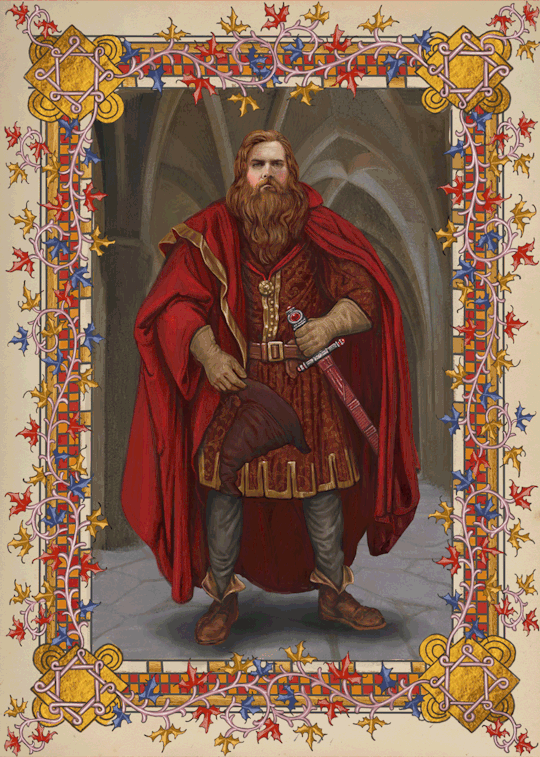
Godric Gryffindor is known to be one of the most powerful duellers of his time. Another interesting fact about him is that some called -- and still call -- him the “crusader against Muggle discrimination”.
Of all the founders, Godric Gryffindor was closest friends with Salazar Slytherin. However, as most of you might have already known, there was a large argument between these two friends when they noticed the difference in what they would like Hogwarts to become.
Like the other founders, Godric tried to shape the Gryffindor house to be like him: loyal, brave, and fearless. It was known that many times, he stood up for his friends, including Salazar Slytherin.
As Second Years, you will have already gone through your very own sorting ceremony, but did you know that the Sorting Hat once belonged to Godric Gryffindor?
While the founders were alive, they were able to sort the students of Hogwarts into different houses, but they got worried about what to do when they passed on. Relying on all four of them becoming ghosts was an unlikely option. Thus, Godric removed his hat and all four witches and wizards enchanted the hat together to give it the “brains” to sort even when they were no longer available.
Salazar Slytherin
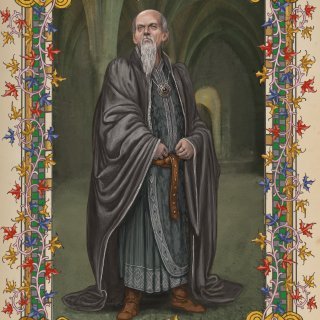
Salazar Slytherin had a great many achievements, beliefs, and discoveries attributed to him, including being an adept Legilimens. Unfortunately, however, the thing about him most people know him for is his belief that magic should always remain within a strict group of pure-blooded families; he insisted the Hogwarts must not allow anyone else into the school. This was also the beginning of the well-known argument between the founders. However, contrary to popular belief, Salazar Slytherin was actually a loyal friend, and not a bigoted villain. His scorning of Muggle-born students was actually born out of a desire to protect the rest of the students in the school, as he believed they may betray them to Muggles.
Salazar Slytherin had a special talent. He was a Parselmouth, meaning he could speak with serpents. It was due to his talent that he was almost killed as a child. He tried to defend a Muggle girl, who was bullied, by speaking to a snake and telling it to attack the aggressors. Frightened, the girl ran home and told her parents about what Salazar had done, causing him to be brutally beaten. Salazar’s parents were able to save him and get their revenge, killing the man, but his hatred of Muggles remained.
Salazar had no idea that Godric was in fact a Muggle-born. When he turned to the other founders for support, he was only met with rejection, as Ravenclaw and Hufflepuff did not see a reason to bar Muggle-borns from their institution.
Students of Slytherin are known to be ambitious and cunning. They would do anything to achieve what they believe in.
Following Salazar’s failed attempt to only accept pure-bloods in the school, he created the Chamber of Secrets and placed a basilisk inside it. This basilisk was placed in order to rid all Muggle-borns in Hogwarts, should the worst come to pass, and fulfill this “noble purpose” Salazar had set for it to do.
Helga Hufflepuff

Helga Hufflepuff came from a very mundane and simple family in Wales. She was the oldest of three children, though the other two children were adopted (one magical and one Muggle). This has allowed her to nurture the motherly characteristics she became famous for and that she has brought to her house in Hogwarts. Caring for her students’ well-being was more important than anything else.
Interestingly, Helga was famous for her wide variety of food-related charms, many of which were, and still are, present in Hogwarts’ feasts. Through food, she was able to form connections with people of many different backgrounds. She had an avid interest in various cultures, Muggle and magical alike. Helga immersed herself in many a culture and was always open to learning about others. This also contributed to her charismatic nature.
Rowena Ravenclaw
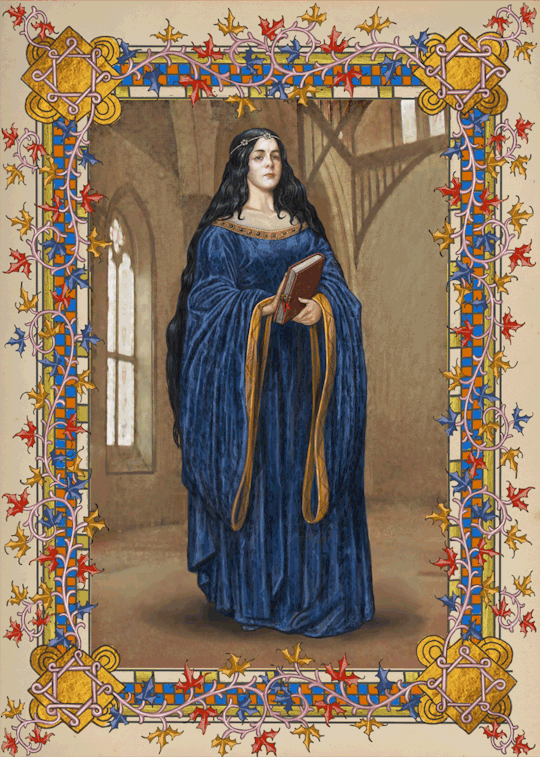
Born in Scotland, Rowena’s maiden name was actually not Ravenclaw. She took the name from her husband, Jares Ravenclaw. Jares was Helga’s cousin. Rowena knew Helga before knowing Jares, and through her friendship with Helga met Jares Ravenclaw, who was ten years her senior. He was persistent in winning her heart, despite her sole interest and love for knowledge rather than relationships. In the end, she was won over with not only his perseverance but also his wit.
As a child, Rowena was always a lover of knowledge and learning. This allowed her to advance her skills in various realms of magic and brought about her interest in magical architecture. It was a relatively rare topic at that time as resources were scarce, but Rowena was determined to use this ability in one form or another. The opportunity arose when Helga introduced her to Salazar and Godric, and thus the idea for Hogwarts was born. Then, she invested all her time into the magical architecture of Hogwarts, the magic behind which is still a mystery to witches and wizards to this very day.
Rowena Ravenclaw became a widow when a wizard’s misfired spell killed her husband. Thus, she brought her daughter, Helena Ravenclaw, with her to live in Hogwarts castle, where she dedicated all her time to teaching and learning. She buried herself in work to distance herself from the hurt in her heart caused by her husband’s death. However, this caused tension between her and her daughter as the latter felt neglected. As a result, Helena later fled the castle with the fabled diadem of wisdom her mother had enchanted. This brought about more hurt to Rowena -- more than she was willing to admit -- as she refused to let go of her pride and denied that her daughter had run away.
Even on her deathbed, Rowena never got to see her daughter one last time. She died of illness and a broken heart in 1000 A.D.
Rowena Ravenclaw had formed the Ravenclaw house with knowledge and wisdom above all else, and had a fair bit of trouble establishing relationships with people. Instead, she sought comfort in her collection of books that was later donated to the Hogwarts Library. The amount of books from Rowena make up a substantial part of the Hogwarts Library to this very day.
1 note
·
View note
Text
Astronomy| Thursday. July 5th, 2018| Lesson Six: Moons of the Solar System [part1]
Moons of the Solar System
Moons are natural satellites - essentially astronomical bodies - that orbit a planet. Of the eight planets in the Solar System, the only planet with only one moon is ours - the Earth. As such, we refer to our Moon with a capital “M”, while we refer to satellites of other planets as “moons” with a lowercase “m”. The Earth-Moon relationship also stands out because, in terms of size, the Moon is relatively big compared to the Earth. The word “lunar” is an adjective that refers to “of the Moon” - notice the capital “M”.
In the Solar System, it is very common for planets - especially the gas giants (Jupiter, Saturn, Uranus, and Neptune) to have moons. The Inner Planets tend to have fewer moons - Mercury and Venus have no moons; Earth has one moon, and Mars has two moons. The Outer Planets, however, are known for their many moons.
At the time of this lesson, Jupiter leads the Solar System moon count with a whopping 67 moons. Saturn comes a close second with 62 moons - I will save the discussion of Saturn’s moons for next week’s guest lecture by Professor Mathieu. Although Galileo Galilei was the first to discover that Jupiter has moons while observing the planet in 1610, the majority of the moons of Jupiter have been discovered in the 21st century. This, of course, shows that even today, Astronomy still remains a cutting-edge and rapidly growing field of study. Some of Jupiter’s moons, like Callisto, Europa, and Io, are larger than the Earth’s Moon in terms of mass, but many of the more recently discovered moons are only a few kilometers across. With new techniques and devices developed every day, as well as with more people looking at the skies, there probably are yet more moons of Jupiter to discover.
Uranus and Neptune also have many moons; at the time of this lecture, 27 and 14 respectfully. Uranus, the smallest of the Outer Planets in terms of mass but the second smallest (after Neptune) in terms of diameter, has several moons. Its two largest moons, Titania and Oberon, were discovered in the 18th century. The third and fourth largest moons, Umbriel and Ariel,were discovered in the 19th century; the rest were discovered in the 20th and 21st century. The five largest moons of Uranus are so massive that, had they been in orbit around the Sun like the eight Solar System planets and Pluto, they would have met the criteria to be dwarf planets. As for Neptune’s moons, the largest of the bunch,Triton, is known for its still-functioning geysers that rain liquid nitrogen all over the moon. The orbits of the moons are rather unique; I will discuss this more in a future year.
Extended Example: Martian Moons
We spent several lessons discussing the Moon’s magical impact on the Earth. The Moon’s magical power, though gentle, is powerful enough to have a substantial impact on the magic used on Earth. Even though the Moon itself does not create magic, the Moon affects magic on Earth by reflecting it, and by aligning with other Astronomical bodies. Without the Moon, magic on Earth would be very different.

Let us take what we know about the Moon’s magical effect on the Earth and use it to approximate the effect that another planet’s moons have on their host planet. For this exercise, we will use Mars, the only other Inner Planet to have moons. Although Mars is only 10% the mass and just over half the diameter of the Earth, the example of Mars is easy to analyze because the planet only has two moons - Phobos and Deimos.
How are these two moons different from the Earth’s moon? The most noticeable difference that can be seen from these pictures is that both Phobos and Deimos are not round; they are shaped like potatoes.
If you look carefully at both moons, you can see something interesting - their relative size. Notice how the image of Phobos is sharper than the image of Deimos? Not only is Phobos much closer to Mars, but it is also much bigger than Deimos. In terms of size, Phobos is almost two times larger than Deimos in diameter and over five times larger in mass. Although Phobos orbits Mars approximately four times in the time that Deimos orbits Mars once, both Phobos and Deimos are tidally locked to Mars just like the Moon is tidally locked to the Earth - the same portion of the moons faces Mars at all parts of the moons’ orbits.
1 note
·
View note
Text
Potions| Wednesday. June 27th, 2018| Lesson Seven: Wiggenweld Potion
The Wiggenweld Potion is a healing potion with the power to awaken a person from a magically-induced sleep, which gives it the ability to reverse the effects of potions like the Sleeping Draught and the Draught of Living Death.
History
A wizard prince once used this potion to awaken a princess who had been given the Draught of Living Death by the Hag Leticia Somnolens. The prince first put some of the potion on his lips and then kissed the princess.
Brewing instructions
The instructions for brewing the Wiggenweld Potion are thus[7]:
Add salamander blood until the potion turns red.
Stir until the potion turns orange.
Add more salamander blood, this time until it turns yellow.
Stir until the potion turns green.
Add more salamander blood, until the potion turns turquoise.
Heat until it turns indigo.
Add more salamander blood until the potion turns pink.
Heat until the potion turns red.
Add five lionfish spines.
Heat until the potion turns yellow.
Add five more lionfish spines.
Add flobberworm mucus, until the potion turns purple.
Stir until it turns red.
Add more flobberworm mucus, this time until it turns orange.
Stir till it turns yellow.
Add Honey water until it turns back to a turquoise colour.
Add another few drops of boom berry juice.
Stir the potion again, then let it simmer for thirty minutes.
Take the potion away from the heat and allow it to cool, when it is cool its ready for use.
Etymology
"Wiggentree" or "Wiggen Tree" is the name which in the UK is given to the Mountain Ash (a species of the genus Sorbus) because, it has traditionally been used as an anti-witching device.
"Wiggen" from the old Breton means "strength", "bravery" or still "courage". As for "weld", it is an English word which means "join together by heating to the point of melting"'.
Thus, "Wiggenweld Potion" would mean literally "Welder Strength" or "Who Welds the Strength Potion".
1 note
·
View note
Text
Mythology| Monday. June 25th, 2018| Lesson Six: Sumerian Mythology: Major Myths and Magic
The Sumerian Pantheon

As is quite common throughout ancient history, the Sumerian Pantheon is directly related to their creation myth. Nammu is the head of the pantheon and is depicted as “the Primeval Sea”. You may have noted in early Mythology lessons that this concept of a primeval sea or chaos seems is quite common for the top of a pantheon. While at first this may seem like a curious coincidence, I assure you it is not. If you think back to what life was like during this time, much of the focus of daily activities was securing the basic necessities of life, namely food, shelter, and water. Water especially was seen as the giver of life. Without it, your plants would fail, and both you and your livestock would die. Given how crucial water was - and still is - to life, it is unsurprising that these ancient civilizations believed that some sort of water was from where their deities emerged.
Let’s look at that chart again. Nammu’s offspring, An and Ki, form the first tier of the ruling gods. The Pantheon itself is often referred to as the Annuna - that is, the “offspring of An.”
You may have noticed a difference between this pantheon and others you have studied. The pantheon includes gods and goddesses that represent the earth, sky, and elements as we have seen before, however there are also gods and goddesses that represent the physical aspects of the human world - grain, vegetation, and reeds. We can infer from the inclusion of these gods and goddesses the extreme value that the Sumerians placed on their way of life - agriculture being the one advantage they had over all other civilizations at the time.
The Reason for Man and the Great Flood
One of the most interesting of the surviving Sumerian myths is the creation of mankind, as it is rather different from other civilizations’ stories of origin. In the Sumerian myth, the gods were required to till the soil of the newly created Earth and found the chore rather tedious. Fed up with the work, they created man in order to do the work for them.
An unfortunate consequence (at least in the eyes of the gods) of man’s creation was his ability to multiply rapidly. So quickly did the human race grow that it frightened the gods. This fear lead to our second myth - the great flood.
The gods, bullied mostly by the god Enlil who was finding it difficult to sleep with all the ruckus, devised several different plots by which to end humanity. There were famines and drought, but none of them worked. Finally, it was decided that a great flood would wash out humanity.
The god Enki decided that he was not willing to see all of humanity perish. While standing on the opposite side of a wall from a human, he announced the plan and how the human could survive it, thereby fulfilling a promise not to tell anyone directly about what was going to happen. That human - Ziusudra - heeded the advice of Enki and built a great ship to protect his family and the livestock from the flood.
After the floodwaters receded, the gods lamented their decision and chastised Enlil for his folly. Ziusudra was granted immortality for his perseverance and the gods implemented a few changes - namely barren women and a few other “birth control” features - to help limit the population growth.
The Epic of Gilgamesh
The flood story is also mentioned in the Epic of Gilgamesh. The most complete and well known version of this myth is from Babylonian times; however some parts of the epic have survived in Sumerian. In the Sumerian version, Gilgamesh was known as Bilgamesh, and his friend Enkidu was also his servant, a relationship missing from the Babylonian version.
The myth, however, remained the same in its essence. Gilgamesh, two-thirds god and one-third man, was powerful and brutal to his people and boasted to the gods of his might. The gods grew quite tired of his behaviour and sent someone to destroy him - a primitive man named Enkidu. Enkidu and Gilgamesh fought a great battle and somewhere in the midst of the fight became friends.
The two friends went on great journeys and defeated some fairly formidable foes, including the “ogre” Humbaba (Huwawa in Sumerian) whose description more accurately describes a Nundu as opposed to an ogre, and Gugalanna - the Bull of Heaven. Their triumphs were short-lived, however, as the gods were not impressed. They decided that one of the two heroes must die and Enkidu perished after an illness.
Gilgamesh was heartbroken over the loss of his friend and also became terrified by death. He spent a great amount of time after Enkidu’s loss trying to find a way to become immortal.
Through his journeys, Gilgamesh managed to find Ziusudra and begged him for the secret to immortality. Ziusudra told him that if he could stay awake for 6 days and 7 nights, he would become immortal. Of course, Gilgamesh could not complete that task and believed that all hope was lost. After a few more chances at regaining his youth - all of which failed - Gilgamesh returned home and looked at the great empire he had built. He then realized that his legacy was the only piece of him that was immortal and that life cannot be precious if it does not ultimately end in death.
1 note
·
View note
Text
Potions| Monday. June 25th, 2018| Lesson Six: The Girding Potion
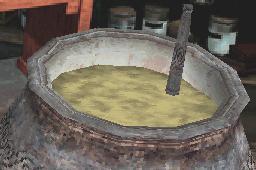
The Girding Potion is a Potion that gives the consumer extra endurance.
Brewing instructions
The following recipe can be used to successfully make the Girding Potion:
Add one set of fairy wings.
Heat until the potion turns turquoise.
Add one measure of doxy eggs.
Heat until the potion turns pink.
Add the toasted dragonfly thoraxes until the potion turns red.
Heat until the potion turns blue.
Add toasted dragonfly thoraxes until the potion turns silver.
Heat the potion until it turns red.
Add three measures of doxy eggs.
Add some dragonfly thoraxes.
Heat the potion until it turns blue.
Add three flying seahorses.
Heat until the potion turns green.
Etymology
From the English "to gird" which can mean one of three things: to encircle or bind with a belt or band; to surround, enclose or hem in; to prepare oneself for action. The latter is probably the intended meaning, a reference to its effects.
1 note
·
View note
Text
Defence Against the Dark Arts| Monday. June 18th, 2018| Lesson Two: Improving Your Concentration
Today we will be working on some basic concepts that can be used to clear your mind and to allow you to strengthen your concentration in order to become a more effective dueler. If you can empty your mind of unnecessary clutter during a duel, you will be less likely to become distracted, which can save your life.
In order to accomplish this, we will be applying the art of meditation to our course. Specifically, we will be using the Buddhist variation, though there are many different types of meditation and I encourage you to do some research and determine a style that works for you. This is simply a method that I have found effective.
Meditation
Now, I want you to take a seat on one of the cushions. Make sure that you are comfortable, because you will be sitting here for most of the class. Cross your legs, one over the other (as some of you may know it, “criss cross applesauce”) to give your body stability.
The second step is to sit with your back straight. You do not want to keep it so straight that it becomes painful, but you do not want to be slouching, either. This posture will allow the energy to flow through your body more easily. If you want to push out negativity, it needs to have a clear path that it can follow that is not contorted.
Next, take your right hand and place it in your left hand. make sure that the thumbs come together and are touching and that the hands are comfortably settled just slightly below your belly button. In Buddhism, hands coming together symbolizes unity and encourages positivity in the body.
Your jaw should be resting the way it usually does and your tongue should be gently placed against the back of your upper teeth. Your head should be tilted down slightly, to help prevent you from looking around and letting your mind wander. This focus will also be helped by keeping your eyes half-closed. You do not want to leave them completely open, which can allow easier distraction, but you also do not want to completely close them or you risk falling asleep or the mind becoming groggy, which is counter-productive to the goals of meditation.
Finally, your shoulders should be resting slightly above the “slumped” level and your elbows should be held just a little away from the body.
Once you are comfortable in this position, begin to focus on your breathing. Make sure that you maintain regular breaths as you breathe in and out. The body’s natural response is to breathe rapid, shallower breaths; try to control that and breath a little deeper, down to your stomach. Become aware of how your body feels as you inhale and exhale. When you exhale, imagine that all stray thoughts are being pushed out of and away from your body. If you happen to have a stray thought while meditating, acknowledge the thought and let it slide out of your body in an exhale.
Try to keep your mind as empty as possible for as long as possible. Do not get discouraged if, early on, you find that you cannot succeed for more than 15 or so seconds. This type of mental awareness and mental clearing takes a lot of practice. I want each of you to work on this meditation each night. Before you go to bed, assume the meditative posture - either the one I have taught you or one that you find on your own - and meditate. I will not give a specific duration, since I cannot tell you how long you will need. Simply work on extending the time your mind can remain empty. Keep up this practice - it may seem tedious or pointless, but it will help immensely in future years when we start discussing spells that require the full attention of your mind.
The Disarming Charm
Now that we have our minds well prepared, I believe it is time to get rid of these cushions and get back to some spellwork. Today I will only be teaching you a single spell, but it is one of the most useful spells I will teach you. The use of this spell is commonly the way to end formal duels - if you opponent is disarmed, then they have no method of attacking and, therefore, are defeated. The Disarming Charms is a well-known favorite spell of Harry Potter; it became the spell he was most known for using and in at least one incident, it was the spell that identified him among a group of imposters and allowed Voldemort to target him.
Now, for your basic components of spellcasting. The wand movement is a spiral that goes clockwise and ends with an outward swish up and to the left. While performing this wand movement, you say the incantation “Expelliarmus” (ex-PELL-ee-ARE-muss).
The concentration required for this spell is simply to focus on the target (the person you are aiming at) and the effect (removing their wand from their hand). The Disarming spell is a Static spell, so once you have seen the spell take effect, you can immediately begin to prepare your mind to cast your next spell.
The willpower that is required is dependent on yourself and the target. The more willpower you put into this spell, the stronger it will become. Less willpower will cause a soft white jet of light to eject from the wand towards your target; higher amounts of willpower will generate a bright red jet of light. Your goal, normally, is to find a middle ground for this spell that generates a jet of ruby red light that is not too bright, but not too weak, either. This will usually be enough that you can overcome the will of your target and force them to be relieved of their wand.
It is important to note that this spell is more difficult to cast on a person who is expecting it, or is at least aware that an attack is coming. This is because they are mentally prepared and can attempt to resist the effects of the spell. If they are mentally ready, it will take more willpower to overcome their will and, in this case, force them to release their wand.
Spell: The Disarming Charm
Incantation: Expelliarmus (ex-PELL-ee-ARE-muss)
Wand Movement: A clockwise swirl ending with an outward swish up and to the left
Concentration: Moderate. Must focus on making the target release their wand.
Willpower: Moderate
1 note
·
View note
Text
Herbology| Monday. June 18th, 2018| Lesson Four: Magical Plants: Venomous Tentacula and Raskovnik
Venomous Tentacula

Venomous Tentacula (Tentacular venimeux) seeds, a Ministry of Magic Class C non-tradeable substance, are dark brown with off-white speckles. Even while in a motionless state, quiet rattling noises are produced by the seeds. This is characteristic of the plant at all stages of life. Nicknames for tentacula in Herbologist circles include "Restless Reedy" and "Tent the Tapper" (in reference to muggle tap dancing). Even under the most stressful of situations, venomous tentacula loves to move. The leaves are the well sought after part of Venomous Tentacula. Depending on the stage of life and quality of care the plant is experiencing, the leaves (and indeed the whole plant) can be either a deep green or a dark purple. Aged, wild, and neglected venomous tentacula all host a shade of purple, while fresh tentacula, or deeply cared for tentacula, will remain a vibrant to darker shade of green. Purple tentacula is not necessarily unhealthy, it is simply not prime for the money market. Dragon dung (a fertilizer, as you will recall from year one) is capable of reviving cuttings of tentacula leaves to a usable state for potions.
There are several uses for Venomous Tentacula. The first is the juice from its plant acts as a poison (to the point of illness, but not death). If swallowed, the victim will endure the sensation of his or her insides burning. A side effect of this is human skin turning a shade of purple. There is no reversal to the changing of skin colour from this plant. First aid in this case would be to swallow a pain-numbing potion. Based on your age and body weight, you would require a Potioneer or Healer to recommend the best one and best dosage.
Several dark potions, which I will not name for you, use Venomous Tentacula for a torturous effect. Potions intended for slow painful deaths, long periods of pain without death, and involving bodily maiming, often utilize Venomous Tentacula for the effect of invoking the sensation of having one's insides burning.
Another use for Venomous Tentacula is dissolving acid. One potion created with Venomous Tentacula leaves is used by Herbologists to lower the pH level of highly alkaline soil. This is why Venomous Tentacula loves high acidic levels in soil… the plant soaks up the acid. In the tentacula life cycle it will recycle the acid for future generations of the plant, but by harvesting only the leaves, and with the additional ingredients in the potion, the pH level of the soil may be permanently lowered. As you will recall from year one, the spell for testing the pH level of the soil is "Acidious Revealious." (ah-sid-EE-us rev-EE-lee-us).
Venomous Tentacula poses a danger beyond its venom. The plant enjoys grabbing unsuspecting victims from behind and strangling them. In order to stun the plant, Diffindo (deef-IN-doe) may be used. Diffindo will also sever the leaves and stem from where it is attempting to strangle its victim.
Raskovnik
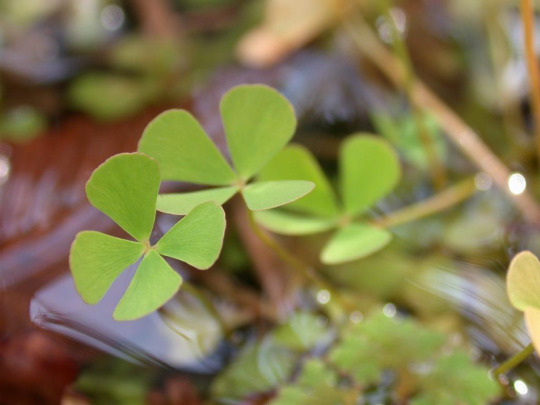
Now let us look at another plant. Raskovnik (Felicita omeritus) is also native to Slavic countries, but can be found almost anywhere in the world. If you can find it, that is. It is notorious for being difficult to find, and not just because it grows best in remote locations. It is an herb that grows only up to several inches tall, and assumes a shape similar to a four leaf clover. Raskovnik grows in meadows, sandy to loamy soil, and will grow in partial to full sun. This herb tends not to be fussy; however, the more light and water it receives the quicker and more comfortably it will grow. Sometimes, Herbologists will classify Raskovnik as a water plant, because it can grow in watery conditions, though it is not necessary.
You may now be wondering, why, if it is a common plant which grows almost everywhere in the world, is raskovnik so hard to find? Well, it’s like this. Very few people are capable of truly recognizing the herb. As a small plant, it is easy to miss or confuse for something else (especially a four leaf clover). Some Herbologists theorize that raskovnik is capable of disguising itself so that we cannot find it unless we already know where the herb is located.
Raskovnik is known for its extra special magical property; the herb is capable of unlocking any door, gate, padlock, chest and the like. Basically, Raskovnik is capable of opening anything closed or locked that crosses its path. This plant is a treasure to any who find it, especially, as one might note, to a thief. Wizards have put this plant to use by storing it inside knives, which come to be known as thieves' knives. A thief's knife is capable of picking the lock of any door, which is due to it containing the herb Raskovnik.
Raskovnik is also capable of uncovering lost treasures. There are several reports of Raskovnik creating a fault line in the earth, and splitting open the ground to reveal treasure in the earth. It is also a suggested ingredient of the philosopher's stone, as some wizards have reputedly managed to turn iron into gold using the herb.
One potion I can confirm the presence of Raskovnik in, is what you will probably know as Liquid Luck (Felix Felicis). Raskovnik is known to help its finder fulfill his or her desires, and thus is an imperative ingredient in the very advanced potion.
Other potions utilize the leaves of Raskovnik because they are diuretic, and febrifuge (capable of bringing down a high fever). They are also anti-inflammatory, depurative (purifying agent), refrigerant (capable of keeping things cool), as well as a revenant (capable of waking one from a deep sleep, such as one induced by the draught of living death). Raskovnik may be used to bring someone back from the brink of death, no matter what poison or illness ails them.
1 note
·
View note